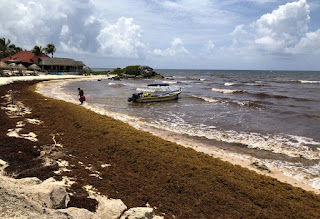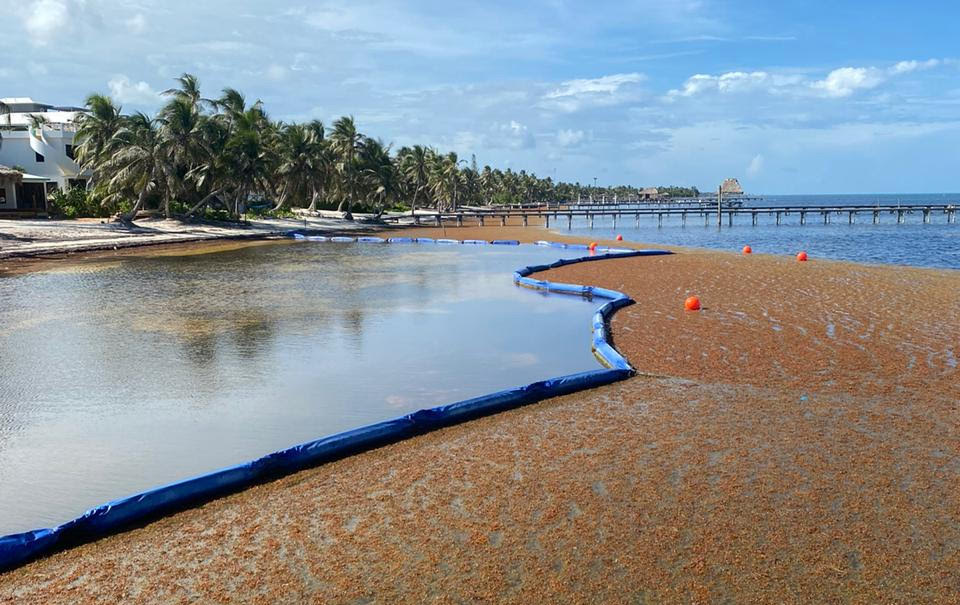Understanding the Sargassum Problem
Sargassum, a type of floating brown algae, is increasingly affecting coastal communities worldwide, particularly in the Caribbean and the Gulf of Mexico. Massive sargassum blooms, known as the Great Atlantic Sargassum Belt, have intensified due to nutrient runoff from agriculture and rising ocean temperatures (Wang et al., 2019). The 2024 bloom is estimated at over 10 million metric tons, making it one of the largest ever recorded (University of South Florida, 2024).
When and Where Sargassum Arrives
Sargassum typically accumulates on beaches from April to October, with peak influxes in July and August (Wang et al., 2019). Major hotspots include:
- Cancún, Playa del Carmen, and Tulum, Mexico
- Barbados, the Dominican Republic, and Puerto Rico
- Florida’s Atlantic coast, including Miami and the Florida Keys

Environmental and Economic Impact
While sargassum serves as a habitat for marine life in open waters, excessive accumulations cause severe issues:
✔ Hydrogen sulfide emissions – When decomposing, sargassum releases hydrogen sulfide (H₂S), a gas that smells like rotten eggs and can cause respiratory issues and corrode infrastructure (Milledge & Harvey, 2016).
✔ Coastal erosion – Large accumulations destabilize beaches and disrupt natural sand movement (Hu et al., 2021).
✔ Tourism and economic losses – In 2018, Mexico spent over $17 million removing sargassum from beaches, as tourism declined (Resiere et al., 2019).
✔ Harm to marine ecosystems – Thick mats block sunlight, depleting oxygen levels and causing fish kills (Lapointe et al., 2021).
Why Traditional Cleanup Methods Fail
Many governments and resorts rely on manual removal and heavy machinery to clear beaches, but these methods are:
❌ Costly – Removal costs can exceed $120 per ton (Desrochers et al., 2023).
❌ Environmentally damaging – Machinery disrupts turtle nesting sites and erodes beaches.
❌ Ineffective – Continuous accumulation makes land-based cleanup a never-ending cycle.
The Best Solution: Floating Containment Booms

The most efficient and environmentally friendly way to manage sargassum is to stop it before it reaches the shore. Floating containment booms, such as the Aquatic Plant & Containment Boom by GEI Works, create a physical barrier that diverts sargassum into designated collection areas.
Key Benefits of Sargassum Booms:
✔ Prevents beach accumulation – Keeps beaches clean by blocking sargassum offshore.
✔ Reduces cleanup costs – Requires less labor and heavy machinery.
✔ Protects coastal businesses – Keeps hotels and resorts open during peak season.
✔ Minimal maintenance – Needs only bi-weekly inspections.
Act Now Before Sargassum Peaks
Sargassum season is here—don’t wait until your beach is covered. Contact GEI Works at +1-772-646-0597 to explore containment solutions tailored to your location.
Refrences:
-
Desrochers, A., Turgeon, C., & Michel, C. (2023). “Cost-effective Strategies for Coastal Sargassum Management.” Marine Environmental Research, 188, 105627.
-
Hu, C., Murch, B., Wang, M., & Lapointe, B. (2021). “The Great Atlantic Sargassum Belt.” Science, 371(6531), 1192-1195.
-
Lapointe, B., Wang, M., & Hu, C. (2021). “Nutrient-driven Sargassum Blooms in the Caribbean: Causes and Consequences.” Environmental Research Communications, 3(3), 035003.
-
Milledge, J. J., & Harvey, P. J. (2016). “Potential uses of Sargassum beyond biofuel production.” Biotechnology for Biofuels, 9(1), 1-22.
-
Resiere, D., Mehdaoui, H., Gueye, P., & Neviere, R. (2019). “Sargassum Invasion in the Caribbean: A Public Health Concern.” The Lancet Planetary Health, 3(4), e145.
-
University of South Florida (2024). “Sargassum Monitoring with Satellite-based SaWS System.” Marine Science Reports.
-
Wang, M., Hu, C., & Barnes, B. (2019). “Tracking Sargassum Blooms in the Atlantic with Satellite Remote Sensing.” Remote Sensing of Environment, 229, 1-12.




